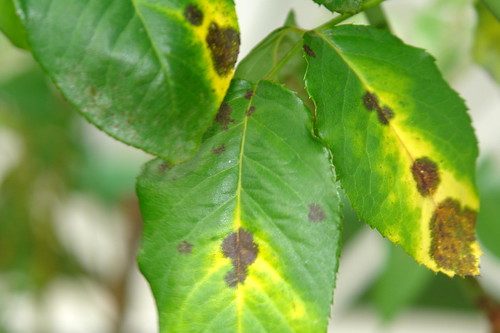Black spot of rose Scot Nelson
TheGardenLady wrote about the roses in her garden that get black spot. Many roses, unfortunately, are affected by this disease. As I had written, one is never to water roses overhead. Mechanical watering devices that come on automatically at a set time are especially problematic in overhead watering. TheGardenLady has seen blackspot in some major rose gardens or botanical gardens that do overhead watering. Also, one should water in the early morning hours so that hopefully water will dry or evaporate from the leaves later in the day. Do not water in the afternoon. Always let the water run near the base of the rose. A soaker hose might be best.
But what should one do if it rains? Mother Nature sends the rain from above at any time of the day or night. And if it is a particularly rainy season, that is when you can usually see a lot of black spot on the rose leaves. Sometimes the black spot can get so bad that it can defoliate the roses to make the plant look unsightly even though the flowers look attractive.Then without leaves, the plant gets sickly and is susceptible to other disease or problems. So what should one do?
First of all, unless you are willing to spend lots of time caring for roses that need lots of care, and willing to use lots of chemicals on these roses that are not disease resistant, look for roses that have been bred to not get black spot and other diseases. You might be willing to get rid of the roses you have that are causing all the extra work because of the disease problems. Even show gardens like the rose garden in the NY Botanical Gardens got rid of roses that were not disease resistant. (see here)
The NY Botanical Gardens replanted roses that easily got diseases with a number of beautiful roses bred by Kordes rose breeders near Hamburg in Germany for their resistance to such diseases as black spot. The Kordes rose breeding program is one of the largest in the world. (see here) There are other rose breeders that have produced or are coming out with disease resistant roses: such as KnockOut roses, the Meilland/Conard- Pyle roses, etc. Read the labels to see if it says disease resistant or do some homework before you buy new roses. (see here)
Remember that a healthy rose is a rose than can fight diseases. Have your soil tested where you want to plant roses to see that it meets nutrient requirements for roses. See that your rose is planted in healthy, rich soil and work in plenty of organic matter such as well-rotted manure or compost. See that the location you will plant the rose is in a sunny spot- they do not want shade unless you live in a hot area like Texas where some afternoon shade is needed. Check with your Master Gardener office to see what is optimum sun requirements in your area if the label on the rose does not specify. See that your plant has room around it for good air circulation. Mulch to retain moisture and then feed and water your roses the right amount- not too much. Keep the area under and around the rose plant clean of weeds and fallen leaves.
If you get a few black spots on the leaves, you do not have to remove the leaves because the plant depends on its leaves to survive. Only remove the black spotted leaves if they are covered with black spot. Throw these leaves away in the trash: do NOT compost them or the fungus will grow in your compost.
There are some methods of preventing black spot. One is spraying with baking soda diluted with water and a few drops of horticultural oil or using a spray of manure tea. For more information on fungicides or other organic methods read this – recipes for both the soda spray and manure spray are in here.

